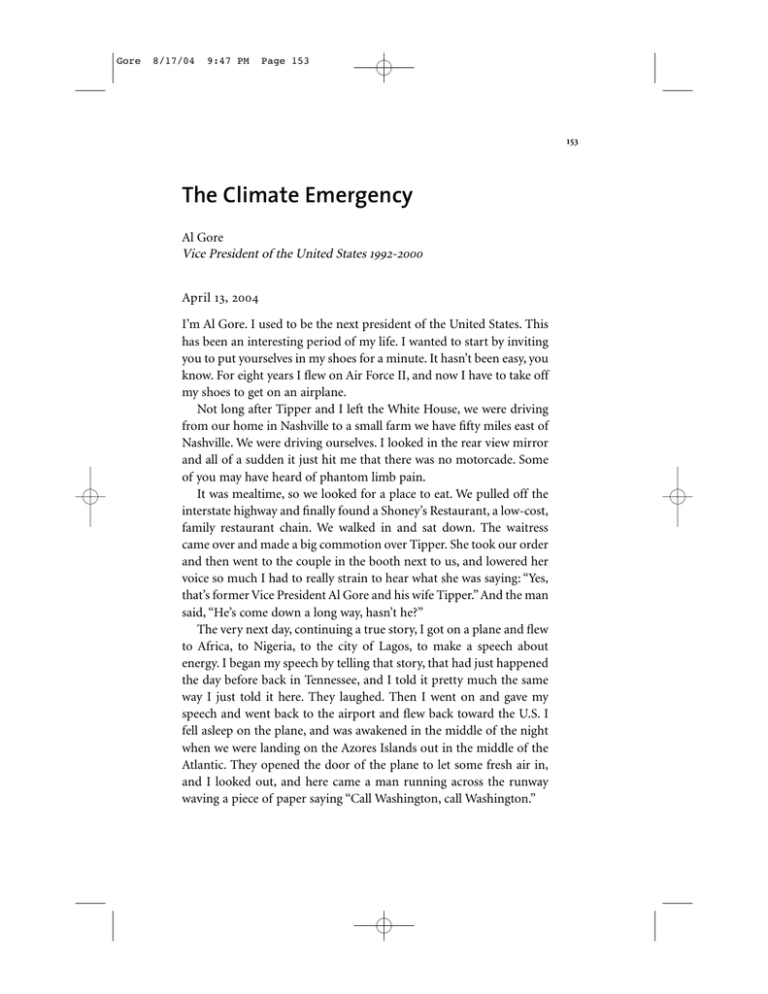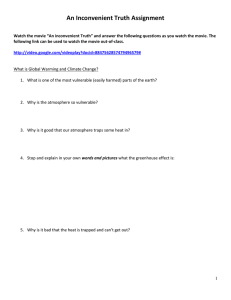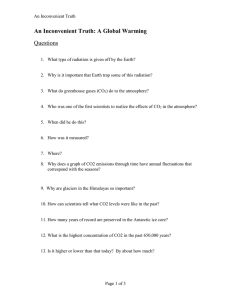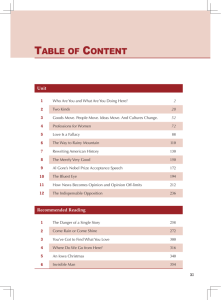The Climate Emergency Vice President of the United States 1992-2000
advertisement

Gore 8/17/04 9:47 PM Page 153 153 The Climate Emergency Al Gore Vice President of the United States 1992-2000 April 13, 2004 I’m Al Gore. I used to be the next president of the United States. This has been an interesting period of my life. I wanted to start by inviting you to put yourselves in my shoes for a minute. It hasn’t been easy, you know. For eight years I flew on Air Force II, and now I have to take off my shoes to get on an airplane. Not long after Tipper and I left the White House, we were driving from our home in Nashville to a small farm we have fifty miles east of Nashville. We were driving ourselves. I looked in the rear view mirror and all of a sudden it just hit me that there was no motorcade. Some of you may have heard of phantom limb pain. It was mealtime, so we looked for a place to eat. We pulled off the interstate highway and finally found a Shoney’s Restaurant, a low-cost, family restaurant chain. We walked in and sat down. The waitress came over and made a big commotion over Tipper. She took our order and then went to the couple in the booth next to us, and lowered her voice so much I had to really strain to hear what she was saying: “Yes, that’s former Vice President Al Gore and his wife Tipper.” And the man said, “He’s come down a long way, hasn’t he?” The very next day, continuing a true story, I got on a plane and flew to Africa, to Nigeria, to the city of Lagos, to make a speech about energy. I began my speech by telling that story, that had just happened the day before back in Tennessee, and I told it pretty much the same way I just told it here. They laughed. Then I went on and gave my speech and went back to the airport and flew back toward the U.S. I fell asleep on the plane, and was awakened in the middle of the night when we were landing on the Azores Islands out in the middle of the Atlantic. They opened the door of the plane to let some fresh air in, and I looked out, and here came a man running across the runway waving a piece of paper saying “Call Washington, call Washington.” Gore 8/17/04 154 9:47 PM Page 154 red, white, blue, and green I thought – what in the world, in the middle of the night, in the middle of the Atlantic, what in the world could be wrong in Washington? And then I remembered it could be a bunch of things. But what it turned out to be was that my staff back in Washington was very, very upset. A wire service reporter in Lagos had written a story about my speech, and it had already been transmitted to the U.S. and printed all over the country. The story began: “Former Vice President Al Gore announced in Nigeria yesterday ‘My wife Tipper and I opened a low-cost family restaurant named Shoney’s and we are running it ourselves.’” Before I could get back to U.S. soil, the late-night comics Leno and Letterman had already started in on me. They had me in a big white chef ’s hat and Tipper was taking orders – “One more with fries!” Three days later I got a nice long handwritten letter from my friend Bill Clinton that said “Congratulations on the new restaurant, Al!” We like to celebrate each other’s successes in life. Anyway, it really is an honor to be here and to share some words about the climate issue. The title I chose for this speech is not a misprint. The phrase “climate emergency” is intended to convey what it conveys – that this is a crisis with an unusual sense of urgency attached to it, and we should see it as an emergency. The fact that we don’t, or that most people don’t, is part of what I want to cover here. climate change: impacts and evidence There is a very famous picture called Earth Rise. A young astronaut named William Anders took it on December 24, 1968. This mission, Apollo 7, was the first one to go around the moon. It went on Christmas Eve, and they had just been on the dark side of the moon, coming back around, seeing the earth for the first time. Anders – the rookie astronaut, without a big fancy camera – took this snapshot and it instantly became an icon. Many people believe that this one picture, Earth Rise, in many ways was responsible for the birth of the modern environmental movement. Less than two years after this picture was printed, the first Earth Day was organized. This picture became a powerful force in changing the way people thought about the earth and about the environment. The environment is often felt to be relatively invulnerable because the earth is so big. People tend to assume that the earth is so big that Gore 8/17/04 9:47 PM Page 155 gore we as human beings can’t possibly have any impact on it. That is a mistake. The most vulnerable part of earth’s environment is the atmosphere. It’s astonishingly thin, as any image from space shows. The space is so small that we are able to fill it up with greenhouse gases, such as CO2, which form a thick blanket of gas surrounding the earth, trapping some of the sun’s radiation. This process, called the “greenhouse effect,” is what leads to increased global temperatures or what most refer to as climate change. In Europe during the summer of 2003, we experienced an extreme heat wave that killed an estimated 20,000 people, and many predict such events will be much more commonplace as a result of increasing temperatures. The anomaly was extreme, particularly in France, with consequences that were well reported in the press. Year-to-year, decade-to-decade there’s variation, but the overall upward trend worldwide since the American Civil War is really clear and really obvious, at least to me. If you look at the glaciers around the world, you see that many are melting away. A friend of mine named Lonnie Thompson of Ohio State studies glaciers, and he reports that 15 to 20 years from now there will be no more snows of Kilimanjaro. This shrinking of glaciers is happening all around the world, including Latin America, China, and the U.S. In our own Glacier National Park, all of the glaciers are predicted to be gone within 15 to 20 years. One of the remarkable things about glaciers is that they really could care less about politics. They either melt or freeze. Rhetoric has no impact on them whatsoever. A few years ago some hikers in the Alps between Austria and Italy were walking along and they ran across what looked like a 5,000-year-old man. Actually he was from 3,000 BCE, and you don’t see that every day. The reason you don’t is that the ice there hasn’t melted for 5,000 years. Every mountain glacier in the entire world, with the exception of a few in Scandinavia that are affected by the Gulf Stream patterns, is melting rapidly. 155 8/17/04 156 9:47 PM Page 156 red, white, blue, and green Lonnie Thompson and his team of researchers don’t just watch glaciers melt. They drill down into the glaciers and pull up columns of ice. Then they study the bubbles of air trapped in the ice, and they can do that year by year because every year there’s a new layer. In Antarctica the layers are paper-thin and they stack up 400,000 years back. Ninety-five percent of all the fresh water in the world is locked up as ice in Antarctica. It’s two miles high. When Lonnie and his team drill down through Antarctica, they’re able to get 400,000 years worth of ice. They can then look at the little bubbles of atmosphere and measure the CO2 content, and they can also measure temperature by comparing the ratio of different oxygen isotopes. However that works, it’s extremely accurate and not controversial. And here’s what that record shows where carbon dioxide is concerned: Tomorrow’s CO2 Concentration 600 Projected Concentration After 50 More Years of Unrestricted Fossil Fuel Burning 550 500 450 400 Today’s CO2 350 300 Concentration CO2 Concentration 250 200 CO2 [ppmv] Gore 20 Temperature in C° 15 10 5 400,000 Years Before Present 300,000 200,000 100,000 Next to Last Ice Age 0 Most Recent Ice Age Now, there are two points here. The first is: Do those lines – the line for level of temperature and the line for concentration of CO2 – look like they go together to you? They do to me. The second point is: Here in New Haven, on the temperature line, the difference of approximately 15°C of average temperature is the difference between a nice day and having one mile of ice over your head. What has been happening lately is that the concentration of CO2 is approaching 380 parts per million. So that’s way, way above anything that has been seen for as far Gore 8/17/04 9:47 PM Page 157 gore back as we can measure – 400,000 years. And within fifty years it’s going to approach 600 parts per million. So if a difference of approximately 200 parts per million of CO2 on the cold side is a mile of ice over your head, what does that much difference represent on the warm side? Or to state the question another way, is it perfectly sane and rational and reasonable to go ahead and do this? Or is it in fact crazy? It is crazy, but that is what the world is doing right now. And fifty years is not a long time. Unless we make decisions very soon, we will reach much higher levels. So, when I use the phrase climate emergency, I have partly in mind the fact that this is happening right now. And it carries with it, unless we do something, catastrophic consequences for all civilization. In Antarctica you’ve heard about ice shelves the size of Rhode Island coming off and calving. There are actually a bunch of them in the Antarctic, and also in Greenland. Incidentally, there was a flurry of publicity on April 9th about a new study showing that if greenhouse gas emissions continue to rise at current rates the disappearance of Greenland’s ice sheet is inevitable, unless we act fairly soon. When ice melts in mountains and in Antarctica and Greenland – when land-based ice melts – it raises sea level. When you have rivers that are close to the ocean like the Thames River in London, the water level goes up, and it threatens the lower lying areas. London, in 1983, built barriers to protect the city against flooding from higher sea level and thus higher storm surges. These barriers had to be closed only once in 1983. Twenty years later, in 2003, they were closed 19 times. Again, the same pattern shows up wherever you look. An area of Bangladesh is due to be flooded where ten million people live. A large area of Florida is due to be flooded. The Florida Keys are very much at risk. The Everglades are at risk. Now the Arctic is very different from the Antarctic because, while the Antarctic is land surrounded by ocean, the Arctic is ocean 157 Gore 8/17/04 158 9:47 PM Page 158 red, white, blue, and green surrounded by land. And the ice in the Arctic is floating on top of the ocean, so it doesn’t get nearly as thick. Instead of two miles thick, it’s only ten feet thick – that is, it used to be ten feet. Just in the last few decades it has melted quite a bit. I went up there twice in a submarine. They have these specially designed submarines where the wings rotate vertically so that they can cut through the ice. Ice in water, or thinner ice, melts more rapidly and leads to temperature increases because, as soon as a little bit of ice melts, the water absorbs a lot more temperature. This effect is now happening to the entire Arctic Ocean. The Arctic ice cap has thinned by 40 percent in the last 40 years. Let me repeat that. Listen to that number. The Arctic ice cap has thinned 40 percent in 40 years. Within 50 years it may be entirely gone. That’s a big problem because when the sun hits the ice cap, 95 percent of the energy bounces off like a big mirror. But when it hits the open ocean more than 90 percent is absorbed. So it’s a phase change, it’s not a gradual change. Ice is that way – the difference between 33F° and 31F° is not just two degrees. That puts more energy into the system and it changes the amount of evaporation off the oceans, so you get more rain and snow but it comes at different times and you get more soil erosion as well. You get simultaneously more flooding and more droughts, which is really a bad thing. You get more precipitation in one-time storm events. More of it comes at one time in big storms. The trend is very clear. What’s behind it all? I’ve come to believe that global warming, the disappearance of the ocean fisheries, the destruction of the rain forests, the stratospheric ozone depletion problem, the extinction crisis, all of these are really symptoms of an underlying cause. The underlying cause is a collision between our civilization and the earth. The relationship between the human species and our planet has been completely changed. All of our culture, all of our literature, all of our history, everything we’ve learned, was premised on one relationship between the earth and us, and now we have a different one. Gore 8/17/04 9:47 PM Page 159 gore three leading causes: population growth, technology, and our way of thinking The new relationship between humankind and the earth has been caused by a confluence of three factors. The first is population, which has been growing rapidly. The population crisis has actually been a success story in some ways. We’ve slowed it down, but the momentum of the population increases is really incredible. Say the scientists are right and we emerged as a species 160,000 years ago. It took from that time, almost 160,000 years until the end of World War II, before we got to a population of 2 billion. Since I’ve been alive, as part of the baby boom generation, it has gone from 2 billion to 6.3 billion. So if it takes more than 10,000 generations to reach 2 billion and one human lifetime to go from 2 to 6, and if I live to the demographic average of the baby boom generation, it’ll go close to 9 billion. That is one of the reasons why the relationship between our species and the earth is different now than ever before. Some of the other global patterns, species loss for example, match the human population pattern. Most importantly, however, the increase in the population of developing nations is driving food demand, water demand, and energy demand, creating intense pressures on human resources. We are seeing a pattern of devastation and destruction that is simply driven by those factors. And it really is a political issue. We in the U.S. are responsible for more greenhouse gas emissions than Africa, South America, Central America, India, and China combined. The world average is way below where we are. Just to recap – this is 1,000 years of carbon emissions, CO2 concentrations, and temperature. This is not rocket science. Those lines match up. The second factor that changes the relationship between humans and the earth is technology. In many ways, it is more powerful and significant than the population explosion because new technologies have increased our power beyond imagination. That’s a good thing often in areas like medicine or communications – you can fill in the blanks. There are all kinds of great things that represent progress. Even cleaning up the environment with new technology. There are a lot of great things that have come out of this, but when we don’t examine habits that have persisted for a long time, and then use the same habits 159 Gore 8/17/04 160 9:47 PM Page 160 red, white, blue, and green with new technology and don’t take into account the new power that we have, then the consequences can get away from us. One quick example: warfare was one thing with swords and bows and arrows and even muskets, but when nuclear weapons were created, the consequences of war were utterly transformed. So we had to think differently about war. And what happened? The cold war emerged and unfortunately the other kind didn’t completely go away, but we’re in the midst of rethinking that age-old habit of warfare. We just have to, because the new technologies make it unthinkable to continue as we were doing in the past. Now think about that pattern: old habits, new technologies. Think about the subsistence that we have always drawn from the earth. The plow was a great advance, as was irrigation. But then we began to get more powerful with these tools. At the Aral Sea in Russia, something as simple as irrigation on a large scale led to the virtual disappearance of the fourth largest inland body of water in the world. We’re changing the surface of the earth, and technology sometimes seems to dwarf our human scale. We now have to try to change this pattern. The third factor is our way of thinking. We have to change our way of thinking. One illustration comes from the fact that, as I said earlier, we have these big assumptions that we don’t question. I had a classmate in the sixth grade. Every time our geography teacher put a map of the world up he would mutter. One time, he got up his courage and pointed to the outline of South America and the outline of Africa and said, “Did they ever fit together?” And the teacher said “Of course not. That’s the most ridiculous thing I’ve ever heard.” In fact, until about the 1960s, the guy who talked about continental drift was thought to be a kook because he said that Africa and South America fit together. It turns out that they did, but the teacher in this story had an assumption in his mind. Continents are so big they obviously don’t move, thereby illustrating the old philosopher’s saying that “What gets Gore 8/17/04 9:47 PM Page 161 gore us into trouble is not what we don’t know. It’s what we know for sure that just ain’t so” (Yogi Berra). We know for sure that the earth is so big we can’t have a big impact on it, but that’s just not so. You know this cliché, I’m sure: That a frog’s nervous system is such that if it’s dropped into a pot of boiling water it will jump right out because it perceives the contrast, but if it’s put in a pot of tepid water which is slowly heated, it doesn’t jump out unless it’s rescued. Here’s the deeper meaning of that cliché: the frog did perceive the sudden boiling water, but did not perceive the slow process. Global warming seems to be gradual in the context of a human life, but it is actually fairly sudden. Another problem with our thinking is that there are people who are paid money by some coal companies and oil companies to go out and pretend that the science says something that it doesn’t say. These are scientific camp followers who are willing to do things for money. And some of the very same individuals who are doing this now (i.e., trying to persuade people that global warming is not a problem) were some of the same people who took money from the tobacco companies after the Surgeon General’s report came out warning of the dangers of smoking. The tobacco companies hired these scientific camp followers to go out and try to confuse the public into thinking that the science wasn’t clear. They produced marketing campaigns like “More doctors smoke Camels.” On a similar note, the Republican pollster Frank Luntz advised the White House that the issue of the environment is important, but the way to deal with it is to make the lack of scientific certainty a primary issue by finding people who are willing to say that it’s confusing when it’s really not. There’s another assumption that needs to be questioned. In contrast to the idea that the earth is so big that we can’t have any impact on it, there are others who assume that the climate change problem is so big we can’t solve it. I, however, believe that we can if we put our minds to it. We had a problem with the ozone hole, a big global problem that seemed too big to solve. In response, we had political leadership and the world passed a treaty outlawing chlorofluorocarbons, the chemicals that caused this problem. 161 Gore 8/17/04 162 9:47 PM Page 162 red, white, blue, and green The United States led the way, and we brought about a dramatic drop in CFCs and are now in the process of solving that problem. We now have the ability to buy hybrid cars like the Toyota Prius and the marketplace for new sources of energy is increasing dramatically. We’re also seeing new efficiencies with energy savings. If we have political leadership and the collective political will to say it is important to solve this problem, we can not only solve it, we can create more jobs, we can create higher incomes, a better way of life, and a higher quality of life by solving the problem. And finally, it’s an issue of values. Back when I was in the Senate, the first President Bush was trying to fend off some of the attacks by myself and many others in Congress who were saying we have to solve this global warming problem. So they had a White House conference on global stewardship. One of their view graphs caught my attention. Their view of the global environmental crisis was represented by a scale with money, in the form of gold bars on one side, and on the other side of the scales was the entire planet. The point they were trying to make was that we have to find a balance between our monetary wealth and the well being of the entire planet. Boy, that’s a tough one! It’s a false choice – because you’re not going to have much wealth if you lose the planet and there is wealth to be made in saving it. We have to get our perspective right. Everything we have ever known – and Carl Sagan made a beautiful long statement about this – all the wars, all the heartbreak, all the romance, every triumph, every mistake, everything we’ve ever known is contained in this small planet. If we keep the right perspective and keep our eyes on the prize, we can solve this problem, we will solve this problem, we must solve this problem. It really is up to you. Gore 8/17/04 9:47 PM Page 163 gore Q&A Q: Getting legislation through the U.S. Congress involves constructing political coalitions. Who are the potential strategic allies that could make a coalition in support of mandatory climate change legislation? How do we get that done? A: The environment used to be more of a bipartisan issue. Back 34 years ago, in 1970, Richard Nixon was president, preparing, he thought, to face a challenge in the presidential election in 1972 from Senator Ed Muskie, who was the leading environmentalist in the Senate. President Nixon tried to co-opt the environment as an issue – and the Clean Air Act, the Clean Water Act, the National Environmental Policy Act, and a lot of other legislation really passed on a bipartisan basis with votes from senators in both parties during that period. What’s different now, among other things, is that the right wing of the Republican Party is so completely in control of that party. Now, I’m a Democrat, I’m very biased, and you’ll have to take it with a grain of salt, but I hear the same thing from moderate Republicans who are deeply concerned. Many of them are afraid to say it anymore because their campaign funding is now controlled by the campaign committees, which are in turn controlled by the right wing. Now the right wing has, as a part of its coalition, companies that try to convince us there’s no problem. And so they fight tooth and nail against any type of progress on the environment. They’re trying to roll back protections against mercury pollution. They have actually blacked out statements of warning from the EPA on the subject of climate change and substituted language paid for by Exxon/Mobil and other companies that try to cloud the issue. That’s not leadership – that’s sabotage. That’s a betrayal of the American people. Bipartisanship depends on having enough health and responsiveness in both political parties to have a genuine dialogue based on the rule of reason. Examine the facts, agree or disagree, debate, try to persuade each other – that’s the American way. But the rule of reason has been tossed aside by many in the current Republican Party and, instead, the rule of power has been substituted. 163 Gore 8/17/04 164 9:47 PM Page 164 red, white, blue, and green Wealth and power have been used in combination to undercut rational debate, to censor the evidence, confuse the people, and avoid the real problem. I’m really troubled by it and I’m hopeful that it’ll change, but one of the reasons I make speeches like this around the country is to do what little I can to try to get evidence before people and say look, be a part of the solution. Because the only way things are going to change is if you decide that you want them to change. Mahatma Gandhi said you must become the change you wish to see in the world. Be that change; manifest it, fight for it, struggle for it. Then we’ll get these kinds of coalitions. Q: What environmental messages resonate most with voters and what environmental issues should the Democrats raise in the campaign? Should they stress the climate issue? A: I think they should, but I think the pollsters will say that the issues which test most effectively and are found year in and year out to be most persuasive are those that people can feel an immediate tangible connection to, like the pollution of water they drink, air they breathe. There are a lot of people who try to find ways to make clear the connections between the climate issue and those issues because, in fact, the same air pollution that causes respiratory disease also causes global warming. One of the challenges that those of us who care about the environment face is that, because of the successes we have had, we’ve actually seen a sharp reduction in the amount of pollution in water and air in most communities in the United States. That causes a false sense of reassurance, when in fact the problem has been shifted to the global arena. Q: You mentioned in your talk a couple of times about individual responses by citizens, how they can help. Can you elaborate on this? A: Well, I’ve seen a lot of examples. I’m now a recovering politician, but during the 25 years or so that I was in elected office, I saw many, many examples of individuals being determined, educating themselves, and making a tremendous difference. There was a young woman in Tennessee who wrote a letter to me about her water tasting Gore 8/17/04 9:47 PM Page 165 gore funny. The well water turned out to have been poisoned by chemical waste that had been dumped three miles away by a company trucking it in from Memphis seventy miles away. One thing led to another, hearings were held, and other examples of such contamination were brought to light, including one that had previously come out in upstate New York at Love Canal. Legislation came out to create the Superfund, the Resource Conservation Recovery Act, and in many ways that young woman in rural Tennessee helped to bring it about. I daresay it might not have occurred if she had not been as determined and persistent as she was. It’s only one example and maybe it sounds corny, or maybe it sounds like a cliché, but I’m telling you, I’ve seen this over and over again. If you feel strongly about an issue and if you’re really willing to educate yourself so that you understand it as well or better than anybody does, and you decide you feel strongly enough about it, you’re not going to give up. Then you will be amazed at how much you can accomplish if you will stay with it. And that’s just a fact. Q: Is the environment going to emerge as a major issue in the 2004 presidential campaign? A: I hope it’s a big issue in the campaign. I think that we do have a crisis in our democracy today. Voting participation has declined. Television now dominates the political dialogue and, as a medium, it is not accessible to the average person. Conglomerates that are not really porous to public opinion and individual expression control it and, as a result, a lot of issues like the environment don’t get much attention. So politicians who make speeches on the environment often don’t see them covered. They’re not really reflected in the national dialogue. Senator Kerry has made a number of excellent speeches about the environment and they’re almost invisible to the American people because there’s an A list and a B list of issues, and the environment is not currently seen on the A list of issues, and it should be, because our future is very much at stake. 165





